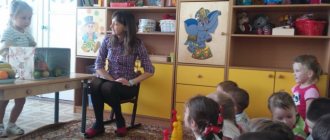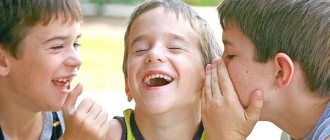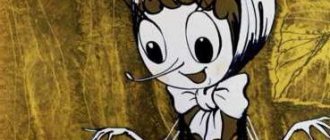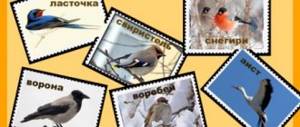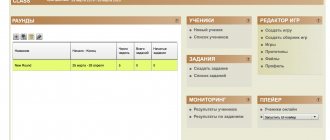Game “Make a chain of words”
Colored picture tab for the game “Make a chain of words”
Coloring pictures for the game “Make a chain of words”
Game “Make a chain of words”
This game will help the teacher conduct classes on the development of phonemic hearing more lively and interesting. By playing it, the teacher helps to assimilate new material and consolidate what has been learned. This material can be used in class or outside of class.
Purpose of the game: to train children in identifying the first and last sounds in words.
Game material: cards with subject pictures (you are presented with coloring pictures that children can happily color themselves and picture material that you can print and get the necessary cards): pencil - cabinet - flag - bush - ax - rocket - bus - bough – key – check – cat – pineapple – catfish – lighthouse – dome – tray – lotus – chest. The cards can be increased in size, cut on the back side and pasted on velvet paper or flannel so that the cards can be used on a flannelgraph. For a board game, we glue the pictures onto thick cardboard.
1 game option:
Each child has a card. The teacher has a card with a picture of a pencil. The teacher says: “Today we will play the game “Chain of Words.” Our chain will begin with the word PENCIL. The next link in the chain will be a word that begins with the sound that ends with the word PENCIL. Which of you finds such a picture, attaches it to mine and names your object so that the last sound of the word can be clearly heard. If two people have pictures whose names begin with the sound Ш, the one who found it first puts down the picture. And the remaining picture is attached later. When will a chain need a word with that sound again.”
Game option 2:
4-6 people play. The cards lie face down in the middle of the table. Everyone takes the same number of cards. The first one to start laying out the chain is the one with the star on the card. The next picture is applied by a child whose name of the depicted object begins with the sound with which the word ends - the name of the first object. The one who runs out of cards first wins.
Didactic games and exercises to familiarize preschoolers with the sound side of words
Didactic games and exercises to familiarize preschoolers with the sound side of words (senior, preparatory group)
The purpose of the games below
— continue to teach children to listen to the sound of words; exercise them in independently naming words and clearly pronouncing the sounds in them; learn to listen carefully and independently find words that sound similar and different.
Stop! Wand, stop!
Children stand in a circle, the teacher is in the center. The game consists of children naming words and at the same time passing a stick to the person standing next to them - a kind of relay race. The participants in the game agree in advance what these words should be. “Which animal are we going to talk about?” - asks the teacher. One of the children (preliminary agreement is possible) suggests: “We will talk about the kitten everything we know.” The teacher agrees and suggests first choosing words about what kind of kitten (selection of adjective words). The teacher hands a wand to one of the children, he says the first word (for example, fluffy) and passes the wand to the next one, he says white-footed and also passes the wand, etc. As a result, the children select many different words: striped, mischievous, troublesome, affectionate , mustachioed, cheerful, black-eared, green-eyed... If someone repeats a word already named or looks for a word for too long, the teacher gives a signal: “Stop! Wand, stop!” This child must get out of the circle. When the stick reaches the middle of the circle, the teacher changes the task: “Now we will select words about what the kitten can do” (selection of verb words). This task is easier than the previous one, so the wand goes around the entire circle of children, each saying one (different!) word: laps, runs, sits, meows, purrs, etc. Gradually, the circle of players narrows due to those making mistakes. Then the teacher invites the two children to remember and repeat all the words named (which kitten is and what it can do) so that the children understand how many words were named and that all the words were different. The teacher asks you to repeat some words so that everyone can clearly hear how they sound. Next time the children can choose a nickname for the kitten (choice of noun words). A similar game can be played to select words to describe other animals, birds, insects, and fish.
Tell Petrushka the sound
Visual material.
Parsley; screen. Parsley tells the children that now he will speak words, but in some words he will deliberately omit one last sound. The children should suggest it. The teacher carefully ensures that the children do not pronounce the entire word, but add only the sound. At first, the sound is suggested by all the children in chorus, then, as directed by the teacher, separately in rows and, finally, individually (to whom the teacher points). Children must quickly suggest the sound unpronounced by Parsley so that the whole word can be heard. Parsley: Children: A black-eared kitten was basking in the sun... k. A white-footed puppy was looking at him... k. The hunters lit a fire in the forest... r. The student held a pencil in his hand... sh. The kid asked his mother to buy a red ball. A hare ran out into a forest clearing... c. An elephant, a hippo... t, a crocodile... lived in the zoo. A spotted woodpecker was knocking on the trunk...l. The squirrel hid the nuts in the hollow... o There were rooster... x chickens... and duck... roaming around the yard. What word is intended?
Visual material.
Subject pictures that depict a daisy, a key, a book, a table, a flower, a closet (for the teacher); tractor, bed, cucumber, bread, snake, duck, jump rope (for children). The teacher shows a picture of a chamomile and says: “This is... a chamomile.” The children smile and correct him: “Chamomile.” He agrees: “That’s what I’m saying - ... a mistake.” In response, children begin to pronounce the word with a deliberate increase in the sound r: rrrromashka. “Why am I not doing it right?” - the teacher is surprised. “You don’t say the r sound, you skip it,” the children explain. The teacher shows the rest of the pictures and also names the objects depicted on them without the first sound (... luch, ... niga, ... tol, ... branches, ... kaf), the children correct the teacher, pronounce the words correctly, highlighting the missing first sound with their voice. Then they begin to show their pictures and name the objects drawn on them in the same way as the teacher - without the first sound. The teacher corrects them. Catch the ball
Children stand in two lines facing each other. Those standing first hold the ball. The game consists of children pronouncing short words in one line, long ones in the other, and passing the ball to the person standing next to them. The game begins at the teacher's signal. If someone says the word incorrectly, the person to whom he passed the ball must hit it on the floor - the point is lost. The teacher and the jury (two more children) count the number of mistakes - lost points. Then the game is repeated from the beginning, but those children who selected long words must now pronounce short ones, and vice versa.
What will happen?
Visual material. Subject pictures: fox, leaf, cat, snake (all names are short); demonstration and individual sound lines No. 2, rope. The teacher displays a picture of a fox on the stand and says that the short word fox needs to be turned into a long one. Children name words (fox, little fox, little fox, little fox, fox...). Children pronounce the short word fox drawlingly and follow the sequential arrangement of sounds with the help of their individual rulers. The teacher demonstrates long words on a large ruler. Then the teacher shows a picture of a leaf, the children change the word, turning it into a long one (leaf, leaves, leafy...). Saying long words, they walk along the rope. Such work is also carried out with the words cat (kitten, kotofey, kitten), already, (ugly, little snake), etc.
Didactic and speech exercises to familiarize children of senior preschool age with the “Proposal” (senior preparatory)
Exercise - working with a sentence.
Target:
Compose a sentence with a given word, determine the number of words in the sentence and name them in order
Description:
The teacher invites the children to make a sentence with a word, for example, TOY (any other word). He interviews 5-6 children, and each of them, having made a sentence, names the number of words in it and the words in order, and draws a diagram.
Exercise “Gather a sentence”
Target:
Make a sentence from the given words.
Description:
The teacher invites the children to choose words from the proposed pictures whose names have a certain sound. Determine what sound is in the names of these words. Make sentences with these words.
For example, from the proposed pictures, choose words whose names contain the sound “t”: snail, pumpkin, tank, shadow, duckling, kitten, shoes, grater, telephone, cobweb, iron, duck, cat, cotton wool. Name the remaining pictures. What is the sound in the names of these words? Make sentences with these words.
Game "Living Words"
Purpose: To practice composing sentences using a structural diagram. Description of the game. Each child depicts a word. Teacher: - Let Slava depict the word “bear cub”; Anya - the word “loves”. Which third word should we choose? (Honey) Read the sentence: “The little bear loves honey.” Let's swap the second and third words. What happened? (The little bear loves honey). Let now the first word become the last. What will happen? (Little bear loves honey). Let's replace the word "honey" with another. Katya will now use the word “tumbling”. Read the sentence (The little bear loves to tumble). And now? (The little bear loves to tumble). Make up your own sentences with the word "bear cub". (The bear cub is clubfooted, The bear cub loves raspberries, The bear cub is sleeping...)
Game “Write a letter to the doll”
Goal: to teach how to determine the number of words in a sentence, relying on auxiliary means. Description of the game. To play, you need to prepare long strips for sentences and short strips for laying out words. The teacher pronounces a sentence, the children lay out a long strip - “write a letter to the doll.” The second time they listen to the same sentence and place as many short strips under the long strip as there are words in the sentence. Then the second and third sentences are analyzed in the same way. After “writing it down,” you can ask someone to “read” the first sentence, the second, and so on, to develop involuntary memory.
FAMILIARIZING CHILDREN OF SENIOR PRESCHOOL AGE WITH THE CONCEPT OF “WORD”
"What is he doing?" Target.
Show children that words are different and they sound different.
Equipment.
Pictures depicting a girl performing various actions: jumping, playing, reading, drawing, singing, washing, running, sleeping, etc. The teacher shows the pictures and asks the children what the girl is doing.
When the children name all the actions shown in the pictures, the teacher offers to list what else the girl can do. If the children find it difficult, he helps them: eat, wash, sing, dance, talk, etc. The teacher draws the children’s attention to how many different words there are about what a girl can do. “Tell me like I do” The goal
is to continue to teach children to listen to words and their sounds: to introduce them to the term “word”; arouse interest in the word. Description: The child approaches the teacher’s table and turns his back to the children. He is an echo. Everyone else remembers some words and, when called by an adult, quietly pronounces them. The echo child immediately names the word he hears (“Cheburashka,” says Valya. “Cheburashka,” echoes the echo). After 5-6 answers, another child is chosen to play the role of echo. New words should be pronounced so that you can clearly hear how they sound. If the echo did not hear the word or “returned” another word to the speaker (for example, instead of a mountain - a city), then another child is chosen for this role. The exercise is designed for greater speech activity of children; everyone is given the opportunity to name one or two words that no one has yet named. The teacher can write down all the named words and read them out at the end, noting their diversity and dissimilarity in sound.
“Which word is missing?”
Target
exercises - to arouse interest in the word. Teach children to name different words on their own. Fix the term “word”. Introduce the fact that words in speech are pronounced in a certain sequence: one after another.
Description:
The teacher invites the children to suggest words that are lost: “The mistress abandoned the bunny - he was left in the rain ... (
bunny
).
Our Tanya loudly... ( cries
), dropped into the river... (
ball
).
Hush, Tanechka, don’t... ( cry
)!
Will not drown in the river... ( ball
).
They dropped the bear on the floor, tore off the bear's... ( paw
).
Anyway, I won’t ... ( give him up
) because he ... (
good
).
The goldfinch sings all day long in a cage on the window. He has entered his third year, and he is afraid of... ( cats
).
That’s how many words you suggested to me, all the words have now been found, and I will read you the poems of Agnia Lvovna Barto with all the words.”
"Silence"
Target:
Teach children to independently find long and short words
Equipment:
Toys and objects found in the group room
Description:
The teacher invites the children to look around and “search” for short and long words. A leader is selected, he walks around the room and looks for objects with a short name. Having found such an object or toy, he stops in front of it and claps his hands. All children watch the actions of the leader and check whether he performs the task correctly. The next leader is looking for items with a long name.
Familiarization with the verbal composition of a sentence
Making proposals about a toy.
During the lesson, children learn to compose sentences from two words and select words from these sentences, indicate the sequence of words (which is first, which is second) 1. There are toys on the table: a doll lies on the bed, a bear sits on a chair; another doll is sitting at the table, the table is set (the doll is having breakfast or lunch); there is a hanger with a towel on it. Educator. - Children, you can say a sentence about each of these toys. Listen, I’ll say a sentence about this doll (points to the doll lying on the bed): “The doll is lying.” Next, the teacher pronounces another sentence of two words (“The bear is sitting”), and then invites the children to make sentences about other toys. Children make up sentences (“The hanger is standing”, “The towel is hanging”, “The doll is sitting”, etc.). Then the teacher asks to say other sentences about the doll (“The doll is having lunch,” “The doll is having breakfast”). One of the sentences, for example, “The towel is hanging,” is repeated in chorus, then the teacher says: “Now listen to how I say this sentence. I'll stop after each word so you can count how many words are in this sentence: "The towel...hanging." How many words did I say? The teacher asks one or two children about the number of words in the sentence. Then questions are asked about what is the first word, what is the second, and what happens if you say them together (“The towel is hanging”); The teacher emphasizes that this is a sentence, not a word. After this, the teacher, calling one of the children, invites him (in a whisper so that others do not hear) to sit down and asks the others to come up with a sentence about this child (“Sasha sat down”). It is disassembled in the same way as shown above. Summing up the lesson, the teacher (in a conversation with the children) concludes that about every object, every person, every animal, you can say a sentence, that sentences consist of words, that today they made sentences from two words.
“Living words”, because in it children become words.
Who wants to be a word? (3 children come out.) Now they are not ordinary children, but word children. You, Masha, are the word “trees”. What word are you, Masha? Say it loud. What word did Masha become? (2-3 children answer.) Tanya - the word “covered”, and Sveta - the word “snow”. (Similar questions are asked to these word children and to the whole group.)
Our words are in order. (Shows the direction - from left to right.) Masha will say her word and give her hand to Tanya, then Tanya will say her word and give her hand to Sveta, Sveta will be the last to say her word. And you all listen.
What did these words mean? (About trees.) What did they say about trees? (The trees are covered with snow.)
Then the teacher asks the children from the field about the sequence of words (“What is the first word? Then what? And then what?”) and asks them to name the words separately (“What is the word Tanya?”, “Show the word “snow”, etc.).
- Now I will clap my hands, and the “words” will go and stand anywhere in the group where they want, and when I call: “Words, stand in your places!” - they will stand in order again.
After the teacher claps, the word children disperse throughout the group.
- Our words are gone. Do you remember them well? Where is the word "covered"? What word is next to the window? Do you remember what they said? (Children answer questions.) I will call out the words, and you check if they stand up correctly. “Words, fall into place!” Did they stand up correctly? (Word children name themselves, and the teacher makes sure that they pronounce the word loudly and then take the hand of the person standing next to them.)
At the end of the game, the teacher asks: “Why is the game called “Living Words”?” and sums up the children’s answers: “The game is called that because the children were the words in it: they took turns pronouncing their words, took each other by the hand, and went their separate ways. group and stood up again in order.”
When playing the game “Find out what has changed”
the teacher calls three and tells each one what word it will be according to the word order of the sentence he has conceived (for example, the first child - the word “chicken”, the second - the word “met”, and the third - “cow”). Immediately, without consistently naming words, children ask: “What happened? Which Proposition?" Then you can ask another question: “What do you think, if instead of the word “chicken” I put another word, will it make a sentence or not?” After listening to the children’s answers, he continues: “I’ll take the word “chicken” and put it aside, and instead I’ll say the word “kitten.” This word will be Olya. What happened now? The children answer: “The kitten met a cow.” “This means,” says the teacher, “you can replace words in a sentence and then you get a new sentence.”
Then the teacher suggests replacing the other two words of the sentence (“met”, “cow”) in the same way. The child who proposes a word for replacement becomes that word. As a result of sequential replacement of all words, a new sentence is obtained. Children should pay attention to this: “First there was the sentence “The chicken met a cow,” and then another sentence came out - “The kitten saw a butterfly.”
Taking into account the capabilities of the children in his group, the teacher can simplify or complicate this version of the game. In the first case, you can take a sentence of two words, in the second, you can start replacing words in a sentence with a verb.
In the game "Confusion"
the same problem is solved - replacing words in a sentence. However, it is carried out without relying on “living words”. Preceding this game, the teacher reads an excerpt from K. I. Chukovsky’s poem “Confusion” (its first part) and asks: “Did you guess why the poem is called “Confusion”?” After the answers he continues: “That’s right. The poem is called that because the animals got everything mixed up. But in reality this does not happen. I also came up with a confusion: “A spiny crocodile is flying.” Do you think this confusion can be unraveled?
As a rule, this game causes joyful revival. The children say it doesn't happen like that. To the teacher’s proposal to untangle the confusion, the answers may follow: “It must be green” or “We must say: “A green crocodile is crawling.” Skillful guidance on the part of the teacher is very important here; he must ensure that the children answer in a certain order, helping with this by asking: 1) “What words need to be replaced to make the correct sentence?” 2) “What word do you want to replace?” After the child answers: 3) “What word will you replace it with?” and 4) “What happened now?” These questions are repeated until the correct sentence is completed.
For example, children unravel the sentence “A green dog is flying.” One child replaces the word “flies” with the word “growls.” The result is the sentence “The green dog growls.” All that remains is to replace the word “green” to get the correct sentence. But another child, busy coming up with his own word replacement, loses sight of the new sentence he receives and says the word “frog.” This does not unravel, but again confuses the phrase, since the sentence “The green frog growls” is obtained. The desire to definitely take part in the task, therefore, should not interfere with concentration. Everyone must quickly select the appropriate word and at the same time monitor the answers of their comrades.
The teacher can offer a variety of confusions, but the number of words in the sentences should not exceed three. At first, you can make it easier to complete the task by offering confusions of two words (for example: “The flowers are crying”) or three, but in which it is enough to replace one word to get the correct sentence (for example: “The plane is crawling high”).
Introduction to syllabics. Word parts
We learn to highlight syllables and designate them graphically. Imagine how you would call your lost girlfriend in the forest. Place your hands to your lips with a mouthpiece and chant Ma-sha I-ra Ma-ri-na. Notice that the words fall apart. Say the words Lu-na, repeat it in a chant with your child. Let him determine how many parts there are in this word. Let him name the first and last part. Introduce him in the same way with monosyllabic three-syllable words: “Mac”, “cat”, “grandfather”, “car”, “magpie”, “butterfly”. Show how to indicate the word graphically do-m do-mi-k do-mish-ko.
Naughty mice
Goal: to develop skills in analyzing and synthesizing the sound of the syllabic composition of words and optimizing auditory-verbal memory. description: reading a poem to adults The friendly mice played literacy Pictures looked at all the letters and named them, They tore off a piece from each word Words - bitterly crying Let's put them together again The mice gnawed off and stole the syllable “juice” so that the pieces turned into words again. Name them in their entirety: pe(juice), but(juice), le(juice), belt(juice), kolo(juice). Game options for synthesizing words with the syllable “RA” ig(ra), No(ra) ga(ra), shku(ra), konu(ra). With the syllable FOR ko (za), ro (za), streko (za), thunder (za), slez (za), past (za).
Didactic game “Count the syllables” Goal: improving syllabic analysis skills. Option 1. Equipment: punched cards with objects on the left and numbers on the right, a writing strip in the middle, felt-tip pens. Progress of the game. Children divide the names of objects into syllables and connect them with a line to a number that indicates the number of syllables in the word.
Option 2. Equipment: punched cards with objects depicted on the left and syllable patterns on the right, a writing strip in the middle, felt-tip pens. Progress of the game. Children divide the names of objects into syllables and connect them with a line to a syllabic diagram, which indicates the number of syllables in a word.
Progress of the game.
For this game you need to have a set of cards that shows a picture and a word in the form of squares and a set of yellow, red and blue squares. Children are asked to pronounce the word , determine the number of sounds in the word , and cover each sound with a yellow square. And then it is proposed to replace the yellow squares with red ones, where the vowel sound is , and with blue ones, where the consonant sound is .
Stage 4.
"Make a soundtrack "
Goal: development of phonemic hearing, teach children to conduct a sound analysis of a word , distinguish between vowels and consonants in a word , hard and soft sounds .
